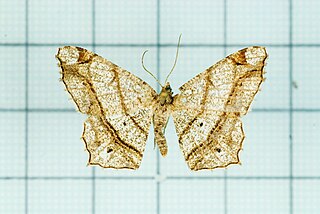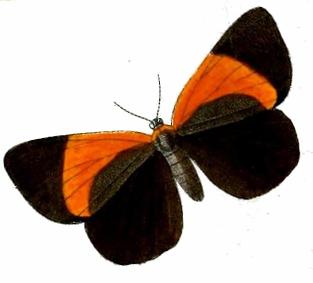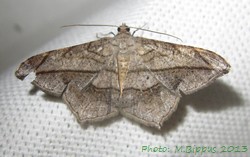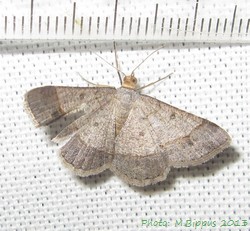
Taiwan, officially the Republic of China (ROC), is a country in East Asia. Neighbouring countries include the People's Republic of China (PRC) to the northwest, Japan to the northeast, and the Philippines to the south. The main island of Taiwan has an area of 35,808 square kilometres (13,826 sq mi), with mountain ranges dominating the eastern two-thirds and plains in the western third, where its highly urbanised population is concentrated. The capital is Taipei, which, along with New Taipei and Keelung, forms the largest metropolitan area of Taiwan. Other major cities include Kaohsiung, Taichung, Tainan and Taoyuan. With 23.57 million inhabitants, Taiwan is among the most densely populated countries.

The latticed heath is a moth of the family Geometridae, belonging to the subfamily Ennominae, placed in the tribe Macariini. The genus was erected by Carl Linnaeus in his 1758 10th edition of Systema Naturae.

The Macariini are a tribe of geometer moths in the subfamily Ennominae. Though they share many traits with the Sterrhinae, this is probably plesiomorphic rather than indicative of a close relationship, and DNA sequence data points to the Boarmiini as particularly close relatives of the Macariini. All things considered, this tribe might still resemble the first Ennominae more than any other living lineage in the subfamily.

Chiasmia is a genus of moths in the family Geometridae. It was described by Jacob Hübner in 1823.

Godonela aestimaria, the tamarisk peacock, is a moth of the family Geometridae. It is found in southern and south-eastern Europe and the Near East.

Chiasmia defixaria is a moth of the family Geometridae. It is found in Asia, including Japan, Korea and Taiwan.

Chiasmia goldiei is a moth in the family Geometridae first described by Druce in 1882. It is found in Australia and Papua New Guinea.

Chiasmia separata is a moth in the family Geometridae first described by Herbert Druce in 1882. It is found on Saint Helena and has also been recorded from South Africa, Angola, Cameroon, Ivory Coast, Kenya, Madagascar, Mozambique, Nigeria, Rwanda, Tanzania and Uganda.
Chiasmia streniata is a moth of the family Geometridae first described by Achille Guenée in 1858. It is found in most countries of subtropical Africa, from Sénégal to Kenya and Sudan to South Africa.

Chiasmia simplicilinea is a moth in the family Geometridae. It is found in eastern and southern Africa from Ethiopia to South Africa and in Ivory Coast & Madagascar.

Chiasmia normata is a moth in the family Geometridae first described by Francis Walker in 1861. It is found throughout of subtropical Africa and Asia, from India, Japan, Taiwan, Sri Lanka. to the Philippines and in Australia.
Semiothisa ozararia, is a moth of the family Geometridae first described by Francis Walker in 1860. It is found in the Indian subregion, Sri Lanka, Taiwan, Borneo, Sumatra and Java.

Semiothisa perfusaria, sometimes placed in the genus Godonela, is a moth of the family Geometridae. It is found in India, Malaysia, and Taiwan.









